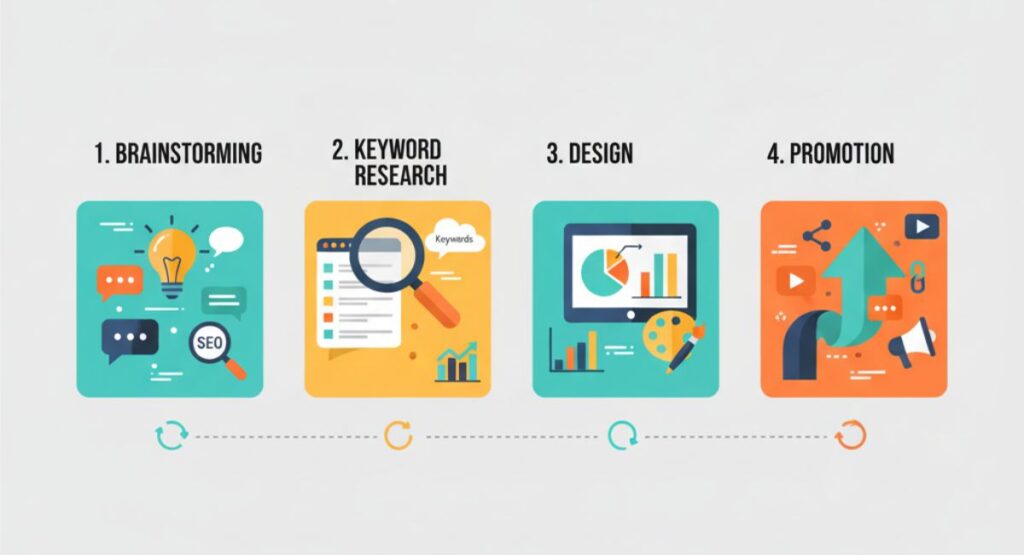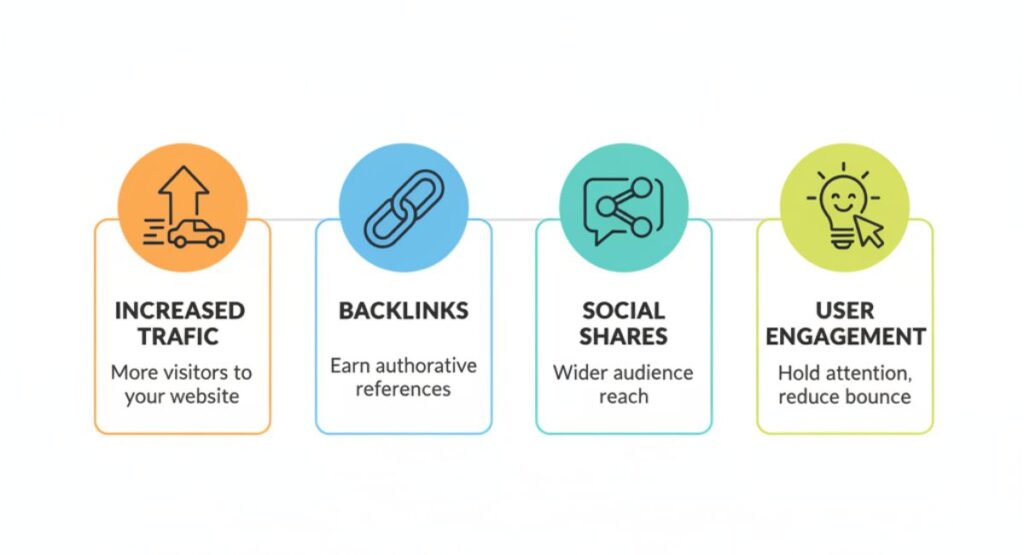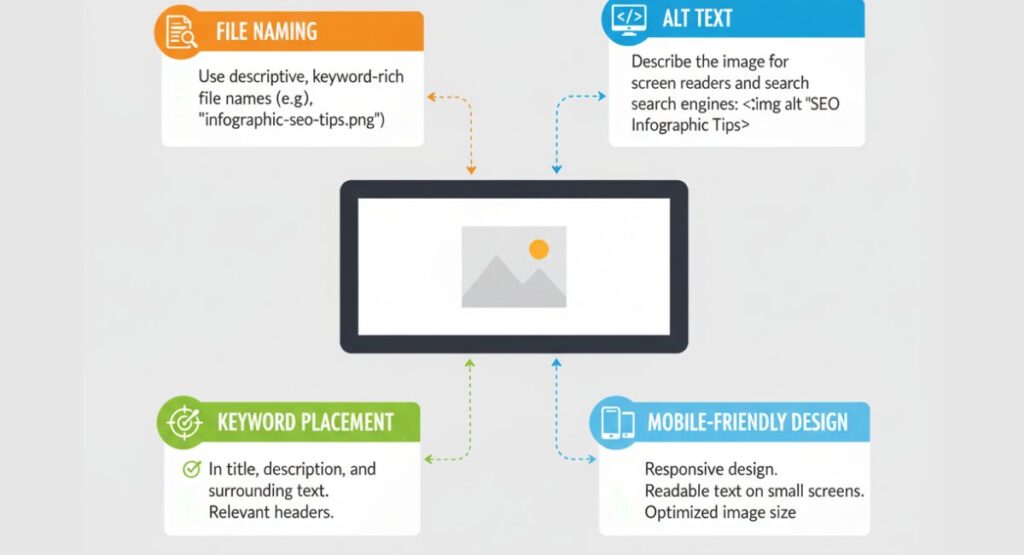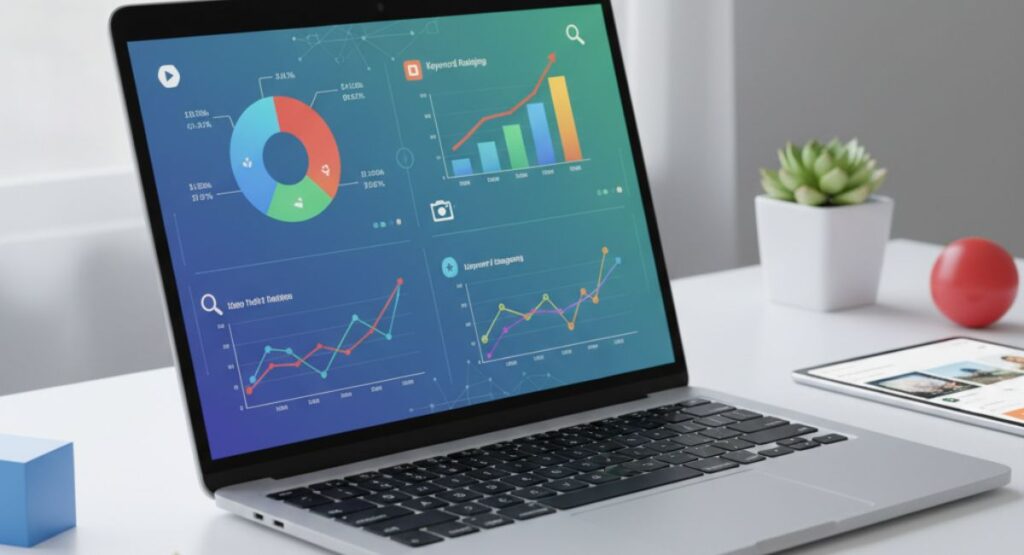In a world where information can be found everywhere, and our attention spans have become getting shorter Combining infographics with SEO is among the most effective methods to be noticed. A simple infographic can transform boring, intricate information into something that is visually appealing. Additionally, SEO ensures people actually get to the informationgraphic. This article will help you be taught how to utilize data visualization and SEO together in a way that is effective. You will learn about what they are, how they’re effective in the first place, how you can apply them, and also real-world infographics as well as SEO examples to help you.
- Infographics SEO Strategy: How to Plan and Execute for Best Results
- Benefits of Infographics: Why They Improve SEO and Engagement
- Benefits of Using Infographics in Practice: Real-World Examples
- Implementing Infographics and SEO: Step-by-Step Guide
- Common Mistakes When Mixing Infographics and SEO, And How to Avoid Them
- Conclusion
- FAQs
Infographics SEO Strategy: How to Plan and Execute for Best Results

To make the most information graphics and SEO for SEO, you must have an effective datagraphics SEO strategy. This is a step-by-step strategy:
- Find Your Topic Using Keyword Intent
Begin by selecting subjects that your target audience is interested about, and that are in line with user intentions to search. Utilize tools like Semrush, Ahrefs, or Google Keyword Planner to discover the primary or secondary keyword. Because your primary focus is on infographics and SEO be sure to search for long-tail variations such as how infographics can improve SEO and visual SEO strategies or informationgraphic ranking factors. - Research Valuable Data and Sources
A good infographic must be valuable, not just a piece of art. Utilize reliable sources such as Statista, Pew Research, or even custom surveys. Always confirm your data and reference sources. - Design that is clear, branding and a Visual Hierarchy
Utilize tools such as Canva as well as Venngage. Use the same color palette, legible fonts and the visual flow (what the eyes are able to see first and then and third, etc. ) as well as the identity of your brand (logo or watermark). - Optimize File, Image SEO & Page Elements
- Use keyword-rich file names: for example, infographics-and-seo-strategy.png.
- Include alt text that describes the infographic, using the primary keyword.
- The image should be surrounded by supporting text to provide some context.
- Make sure the design is responsive to ensure it looks great on both desktop and mobile.
- Use keyword-rich file names: for example, infographics-and-seo-strategy.png.
- Provide Embed Code & Promote
Create an embed code to ensure that users can share the infographic, while linking back to your website. Promote your infographic through outreach, social media directories for infographics, as well as email newsletters. - Measure, Iterate, and Improve
Make use of Google Analytics for traffic metrics, Ahrefs or Moz for backlink tracking and social media insights to share. You can then refine your content and design according to what is successful.
Benefits of Infographics: Why They Improve SEO and Engagement

If you mix infographics with SEO the advantages of infographics are many. Here are some of the main benefits:
- Enhance user engagement: Graphics draw the attention of users quickly. Infographics are a way to break the text into smaller pieces and make information easy to read and keep readers on the page for longer.
- Natural Backlinks: Images that are high-quality tend to get shared on other sites. In the event that they use your graphic, they usually link back to your site, which increases its credibility and improves your search engine ranking.
- The ability to share: Infographics can be customized for use on social media platforms such as Pinterest, Instagram, LinkedIn and X (formerly Twitter). More shares usually translate to more traffic, visibility and social evidence.
- Improved Keyword Reach and Semantic SEO: Infographics help you focus on related search terms and not only the primary keywords. It is possible to optimize the file’s name captions, alt tags as well as the content surrounding it, and headings to incorporate keywords that are relevant to semantics (for instance, images for SEO and image search rankings and infographics’ advantages).
- Lower bounce rates: Since infographics help to make content easier to digest so that users will be more likely leave the page immediately upon landing on a webpage.
- Recall and Brand Credibility Infographics that are well-designed give an impressive impression. People often remember images and could recall your brand name when they revisit it.
Benefits of Using Infographics in Practice: Real-World Examples
To understand the benefits of using infographics translate to tangible improvements, here are a few examples of infographics, as well SEO examples from various sectors:
- Marketing and SaaS The SaaS startup released an infographic that shows how SaaS growth funnel and data over time. They also added embedded code. Within weeks, they had many backlinks from marketing blogs and organic traffic increased by 20%.
- The Health & Wellness: A clinic made use of an infographic to describe the 10 signs of dehydration that are warning using visuals as well as icons and statistics. The image was redesigned and Facebook shares began to bring more traffic to the site, which increased its visibility.
- E-commerce: A website made an infographic to compare their product offerings with selected rivals. The graphic was distributed via social media and embedded to comparison blogs, thereby increasing traffic and boosting conversion rates.
- Education: A university created an infographic on study tips to help students learn remotely, which was included in emails to students and as PDFs that can be downloaded. It boosted dwell time as well as was shared among students, and improved the visibility of organic search results for related searches.
These examples show how the advantages of infographics aren’t only theoretical, but can result in real SEO enhancements, growth in traffic as well as brand recognition.
Implementing Infographics and SEO: Step-by-Step Guide

Here’s a comprehensive guideline of how to incorporate infographics and SEO in your workflow for content.
| Step | Action | Why It Matters |
| Step 1: Topic & Keyword Research | Find relevant keywords. Select the keyword that is your primary (infographics or SEO) and secondary keywords. Find out what people are searching for. | Make sure your infographic is targeted at the information that users are looking for, and helps to reduce wasted effort. |
| Step 2: Data Gathering & Validation | Collect data, graphs, credible facts. Cite sources. | It builds trust, bolsters claims, and increases the probability to buy shares as well as backlinks. |
| Step 3: Design & Layout | Draw wireframes, select icons and visuals to format them to be mobile-friendly. | Enhances readability and aesthetics, improving sharing. |
| Step 4: SEO Optimization of Image File | Name the file using keywords include alt text. compress, select a the web-friendly image format (PNG WebP, SVG, PNG). | Helps search engines comprehend your content and load it quickly. |
| Step 5: Write Supporting Content | Introduction, explanation of the infographic, its context, or summary. | Offers textual information Google can crawl, and its users are able to read. |
| Step 6: Publish | Include an infographic on the blog or on your website. Set metadata (title, meta description) including focus keyword. | Aids in improving the page rank for relevant search terms. |
| Step 7: Promotion & Embed Code | Create embed codes; reach out and post on social media and send directories. | Drives backlinks shares, drives and refers traffic. |
| Step 8: Monitor & Iterate | Utilize Google Analytics, backlink tools Social metrics, backlink tools; find out what is working; then refine your the infographics to come. | Continuous improvement maximizes results. |
Common Mistakes When Mixing Infographics and SEO, And How to Avoid Them
With a solid plan there are some mistakes that can hinder efficiency. Here are some common mistakes with solutions:
| Mistake | Problem | How to Fix |
| Too much text/visual clutter | Readers get overwhelmed. They go away. | Use only minimal text; make use of icons, bullet points and white space. |
| Poor optimization (alt text, file name) | Search engines aren’t able to fully comprehend the informationgraphic. | Always include alt text and Keyword-rich file names. |
| Non-responsive design | Mobile devices can cause informationgraphic is cut off or rendered unreadable. | Test on tablets and phones Design with flexible layouts. |
| The absence of original information or insights | It appears generic and more likely not to get shared and linked. | Utilize new data, fresh statistics, personal data or even new angles. |
| There is no context or article to support it. | Informationgraphics on their own might not be highly rated. | Always ensure that you have good-written content. |
Conclusion
Utilizing infographics as well as SEO combined will give your content visually appealing and increases search visibility. If you are careful and design well and optimize your site smartly, as well as spread the word, the benefits could be significant.
The next steps are as follows:
- Choose a subject that can be used to create visual storytelling
- Do your research thoroughly and collect reliable information
- Create an infographic that appears appealing and is easy to read
- Make sure you optimize every technical aspect (file name alt text, file name.)
- Write the text that will support the infographic
- Publicize, promote and track
If you begin with just one info graphic and follow the process closely, you’ll be able to see an increase of organic search traffic backlinks quantity, social engagement as well as your page’s ranking.
FAQs
Are infographics still relevant in 2025?
Yes. visual content is still extremely effective. If your infographic is useful well-designed, optimized, and promoted, it will still provide powerful benefits for search results as well as user engagement and the reach of your brand
What is the best way to measure success?
Measurements to track include: a long-lasting time on the page, growth in backlinks as well as social shares. decrease in bounce rate and higher ranking for keywords related to the topic
Which size, or what format do I choose?
Try to keep widths between 600 and 800 pixels to make it easier to read; keep the file size to less than 1MB. Choose formats such as PNG, SVG, or WebP to improve clarity and reduce size.
Can I reuse some in an infographic?
Absolutely! Divide sections into slides, social media posts video clips or embed them in newsletters. Repurposing can increase reach and improve ROI.

I’m SEO expert and content writer at SEO Guest Pro.
I help websites rank higher, get more traffic, and grow fast using smart SEO and engaging content.
Let’s grow together!

